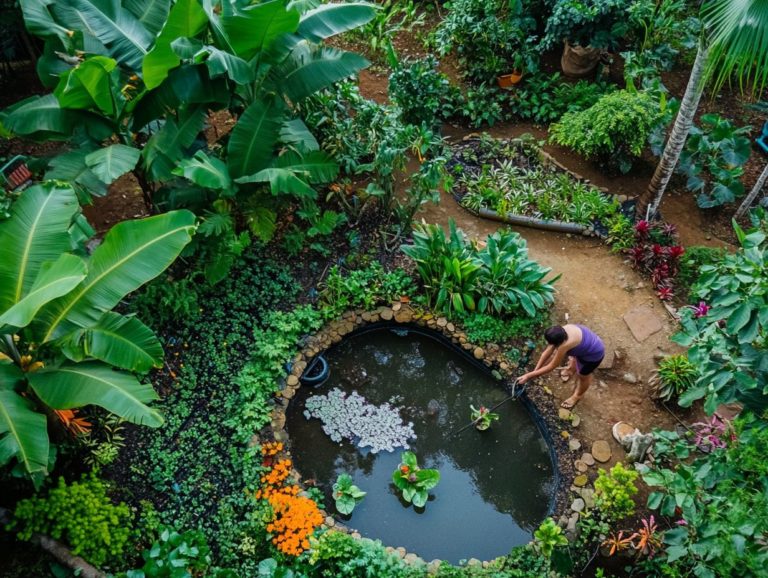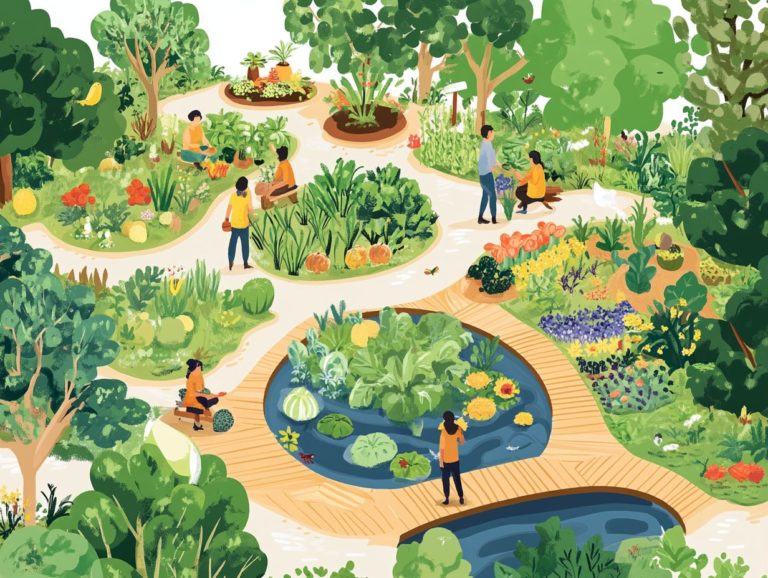68. How to Promote Biodiversity in Community Gardens
Biodiversity is essential to the vitality and health of community gardens and home gardens, elevating them into flourishing ecosystems.
This article delves into the significance of biodiversity within these shared green spaces. It showcases its environmental benefits and the positive impact it has on the community. The article examines the factors that affect biodiversity and agricultural production, outlines effective strategies for its enhancement, and provides insights on how to actively involve the community in these initiatives.
By comprehending and championing biodiversity, you can cultivate more resilient and enriching gardens that enhance food security and benefit everyone involved.
Contents
- Key Takeaways:
- Understanding Biodiversity in Community Gardens
- Benefits of Promoting Biodiversity in Community Gardens
- What Impacts Biodiversity in Community Gardens?
- Ways to Promote Biodiversity in Community Gardens
- Engaging the Community in Biodiversity Efforts
- Measuring Success and Continual Improvement
- Frequently Asked Questions
- 1. What is biodiversity and why is it important for community gardens?
- 2. How can I attract beneficial insects to my community garden to promote biodiversity?
- 3. Is it important to use native plants in community gardens for promoting biodiversity?
- 4. How can I prevent the use of harmful pesticides and chemicals in my community garden?
- 5. Are there any specific gardening techniques that can help to promote biodiversity in community gardens?
- 6. How can community gardeners collaborate with local wildlife organizations to promote biodiversity?
Key Takeaways:

- Plant native species to boost biodiversity and support local ecosystems.
- Engage your community through fun educational activities and collaborations with local organizations to increase biodiversity in community gardens.
- Implement sustainable gardening practices to create habitats for wildlife and promote biodiversity.
Understanding Biodiversity in Community Gardens
Biodiversity in community gardens is crucial for enhancing ecosystem services and bolstering food security, particularly in an era marked by climate change and its repercussions on agricultural production. These gardens grow food and cultivate genetic diversity among plants. They also establish local food systems that enhance food security and empower communities to take charge of their nutritional resources.
Grasping the various facets of biodiversity is key to developing sustainable urban agriculture practices that benefit both the environment and local residents. By nurturing diverse plant genetic resources, community gardens can effectively address malnutrition while building resilience against environmental challenges.
What is Biodiversity?
Biodiversity encompasses the rich variety of life on Earth, including genetic diversity, species diversity, and ecosystem diversity all essential for sustaining ecosystem services. This diversity isn’t merely about quantity; it also involves the intricate web of interactions between species and their environments.
In the realm of community gardens, introducing a diverse array of plant species and genetic variations fosters a thriving ecosystem. Genetic diversity is particularly crucial. It enhances resilience and enables communities to adapt to shifting climate conditions and pest challenges. By nurturing diverse plant genetic resources, community gardens bolster local food systems, improve soil health, and encourage community engagement. This holistic approach ultimately contributes to environmental sustainability and enhances human well-being, especially for indigenous communities.
Benefits of Promoting Biodiversity in Community Gardens
Promoting biodiversity in community gardens offers a wealth of advantages! It enhances ecosystem services, bolsters food security, and elevates nutritional standards while supporting local food systems and agricultural production.
Nurturing a diverse range of plants, including landraces and crop wild relatives, improves soil health and increases resilience against pests and diseases. This provides vital habitats for wildlife, creating a balanced farm ecosystem that fosters sustainable livelihoods.
Cultivating a variety of crops plays a crucial role in alleviating malnutrition and promoting the overall well-being of the community. Join us in promoting biodiversity in your community garden! Together, we can make a difference!
Environmental and Community Benefits
The environmental and community benefits of biodiversity in community gardens are remarkable. They offer advantages that extend from enhanced ecosystem services to promoting sustainable livelihoods and addressing malnutrition and other pressing environmental challenges.
These vibrant gardens see significant improvements in air and soil quality through natural processes like nutrient cycling and carbon sequestration, which is the process of capturing and storing carbon dioxide to help reduce climate change. They also bolster climate resilience, acting as crucial buffers against extreme weather events.
Community gardens create essential habitats for a variety of species, supporting local wildlife and contributing to overall ecological balance. This balance is vital for combating extinction.
Community gardens serve as vital hubs for social cohesion, where individuals come together to learn, share resources, and collaborate on projects. This interaction fosters educational opportunities and encourages engagement with nature while embracing sustainable practices. This cultivates a sense of stewardship that benefits both the environment and the community.
What Impacts Biodiversity in Community Gardens?
Numerous factors influence biodiversity in community gardens, including human activities, climate change, and agricultural practices that can either impede or promote ecological health.
Urbanization often leads to habitat loss and pollution, disrupting the natural balance. Climate change presents unpredictable challenges that threaten the intricate dynamics of local ecosystems.
Recognizing these elements is crucial for managing community gardens effectively. Fostering biodiversity helps enhance resilience against environmental shifts.
Impact of Human Activities

Your activities, especially in urban agriculture, profoundly impact biodiversity, reshaping natural habitats and introducing new environmental challenges.
This transformation often occurs through land development, where precious green spaces are paved over or repurposed for residential and commercial projects, disrupting the balance of local ecosystems.
The use of pesticides in community gardens can decline beneficial insect populations, such as pollinators, essential for plant reproduction. Additionally, resource consumption like excessive water use and reliance on non-renewable materials further strains the environment.
It s vital to grasp how your actions shape the environment. By adopting sustainable practices and emphasizing urban agriculture, you can enhance soil health, support native species, and cultivate a resilient agroecosystem that benefits both you and the wildlife around you.
Ways to Promote Biodiversity in Community Gardens
Promoting biodiversity in community gardens requires a thoughtful blend of strategies, such as planting native species, fostering habitats for wildlife, and embracing sustainable gardening practices. For those interested in innovative approaches, exploring how to use technology for community gardening can also enhance food security and nurture healthier ecosystems, which are essential for community health.
By incorporating a diverse array of plant genetic resources, you can cultivate resilient agroecosystems that cater to the needs of your community while standing strong against climate change and environmental degradation.
Join us in making a difference your garden can be a sanctuary for biodiversity!
Planting Native Species
Planting native species in your community gardens is a crucial strategy for enhancing biodiversity and supporting local food systems. These plants are perfectly adapted to your local climate and soil conditions, making them an excellent choice.
By incorporating flora that naturally thrives in your region, you can create vibrant habitats that attract a variety of wildlife, including essential pollinators like bees and butterflies. These creatures play a vital role in maintaining healthy ecosystems.
Native plants also improve soil health by enhancing its structure and promoting beneficial microorganisms. This results in more resilient garden spaces.
They significantly contribute to important services that nature provides, such as water retention and erosion control, all while reducing your reliance on chemical fertilizers and pesticides.
Ultimately, using native species fosters a sustainable environment and supports sustainable livelihoods, benefiting both you and the wildlife that shares your space.
Creating Habitats for Wildlife
Creating habitats for wildlife in community gardens is crucial for promoting biodiversity and allowing various species to thrive. This ultimately enhances vital services provided by nature, such as pollination and pest control.
To achieve this, you can implement several effective techniques in urban agriculture. One key strategy is to incorporate native plants, as these species are better suited to local conditions and provide essential food sources for pollinators and other wildlife.
Additionally, establishing water sources, like birdbaths or small ponds, can attract diverse fauna, helping to create a dynamic ecosystem.
It’s equally important to choose organic methods to protect beneficial insects and help our planet thrive. This fosters a healthier environment overall, combating the effects of climate change.
By adopting these practices, you can cultivate a flourishing garden that supports wildlife while enhancing your garden’s productivity.
Implementing Sustainable Gardening Practices
Implementing sustainable gardening practices is essential for maintaining biodiversity in community gardens, especially as you navigate the challenges posed by climate change and environmental shifts.
By embracing methods like organic farming, you can minimize the use of harmful pesticides and fertilizers. This cultivates a healthier habitat for a variety of species.
Incorporating water conservation practices, such as collecting rainwater for garden use and drip irrigation, optimizes your resources and helps preserve local aquatic ecosystems.
Engaging in crop rotation enhances your soil health and fertility, promoting a dynamic ecosystem where nutrients remain balanced and pests are naturally managed.
These holistic approaches significantly contribute to establishing resilient gardens that support not only local wildlife but also sustainable food production.
Engaging the Community in Biodiversity Efforts
Engaging the community in biodiversity efforts is crucial for cultivating a sense of collective responsibility and inspiring action toward environmental stewardship. This is particularly important in urban environments where biodiversity faces challenges, especially in preserving local wildlife and trees.
By collaborating with local organizations and including indigenous communities, you can enrich gardening practices and deepen the understanding of local ecosystems.
Educational initiatives play a vital role in raising awareness about the benefits of biodiversity. They encourage community members to participate in sustainable gardening efforts.
This, in turn, strengthens local food systems and enhances nutritional security.
Act now to join the fight for our local wildlife! Join us today to make a difference in your community!
Collaborating with Local Organizations

Collaborating with local organizations offers you a powerful avenue to enhance biodiversity in community gardens. These partnerships can provide you with valuable resources, expertise, and support for sustainable practices.
When community gardens join forces with local conservation groups, you tap into a wealth of knowledge that can foster a richer variety of plant and animal life. Such collaborations not only aid in implementing eco-friendly practices but also engage residents in workshops and educational programs. This leads to greater awareness within the community.
Successful partnerships often involve local schools teaming up with these gardens. This collaboration allows students to learn about native species while cultivating healthy ecosystems.
These initiatives illustrate how shared goals can elevate biodiversity and strengthen community bonds, enriching your gardening experience.
Educating and Involving Community Members
Educating and engaging community members in biodiversity initiatives is essential for crafting a sustainable future and deepening your connection to local ecosystems.
By adopting various educational strategies think interactive workshops, hands-on gardening sessions, and well-organized informational campaigns you can effectively involve individuals of all ages in these vital discussions. These activities not only raise awareness about biodiversity but also empower you and your neighbors to take meaningful action in preserving the environment.
For example, hands-on gardening sessions equip participants with practical skills while highlighting the significance of native plants. Outreach efforts that spark conversations around local flora and fauna can greatly enhance local stewardship.
Your involvement in community initiatives fosters a shared sense of responsibility for protecting natural habitats and paves the way for a collaborative approach to sustainability.
Measuring Success and Continual Improvement
Measuring success and fostering continual improvement in community gardens is crucial for grasping the true impact of biodiversity initiatives. This ensures that biodiversity goals are effectively achieved.
By setting clear success metrics, you can monitor biodiversity levels, track your progress, and adapt your practices to enhance ecological health over time. This ongoing evaluation bolsters local food systems and strengthens the overall resilience of your community in the face of environmental challenges.
Start measuring your success today to ensure your efforts lead to lasting change!
Monitoring Biodiversity Levels
Monitoring biodiversity levels in community gardens is essential for assessing the effectiveness of your gardening practices and understanding the local ecological health.
By employing methods like species counts where you and your volunteers record the variety and number of plants and animals present and conducting soil assessments, you can gain deeper insight into your community’s environmental impact.
Gathering feedback from community members allows for a clearer understanding of local perceptions and knowledge of biodiversity, empowering you to make informed decisions.
These metrics guide sustainable gardening practices and bolster the resilience of ecosystems, ensuring that your community gardens can flourish while fostering educational opportunities and stewardship among residents.
Ready to enhance biodiversity in your community? Start collaborating with local organizations today!
Adapting and Expanding Efforts
Adapting and expanding your efforts to promote biodiversity in community gardens is essential for tackling emerging challenges and enhancing environmentally friendly practices. By implementing effective monitoring strategies and actively seeking input from local gardeners, you can gain a deeper understanding of the unique needs within your ecological environment.
This feedback loop creates a teamwork environment that thrives on shared ideas and creativity! It not only addresses immediate challenges but also anticipates future ones.
Introduce exciting new plants and creative gardening methods! These not only boost local biodiversity but also lead to healthier soil and effective pest management. Such initiatives attract pollinators and beneficial insects while creating an engaging atmosphere where individuals can learn, share, and grow together, ultimately benefiting the entire community.
Frequently Asked Questions
1. What is biodiversity and why is it important for community gardens?

Biodiversity, which means the variety of living organisms in an ecosystem, is crucial for community gardens. It helps to create a balanced and healthy environment for plants and wildlife, leading to improved overall garden health and productivity.
2. How can I attract beneficial insects to my community garden to promote biodiversity?
One way to attract beneficial insects is by planting a variety of flowering plants and herbs. These plants provide food for pollinators and attract other beneficial insects that prey on pests, helping to keep your garden ecosystem in balance.
3. Is it important to use native plants in community gardens for promoting biodiversity?
Yes, using native plants is crucial for promoting biodiversity. Native plants have evolved to thrive in the local ecosystem, providing habitat and food sources for native insects, birds, and other wildlife. This ultimately helps maintain a diverse and healthy garden environment.
4. How can I prevent the use of harmful pesticides and chemicals in my community garden?
Preventing the use of harmful pesticides and chemicals can be achieved by implementing organic gardening practices. This includes using natural pest control methods, such as companion planting and handpicking pests, along with organic fertilizers and soil amendments.
5. Are there any specific gardening techniques that can help to promote biodiversity in community gardens?
Yes, several gardening techniques can promote biodiversity. These include crop rotation, intercropping, and polyculture planting, which create a diverse and balanced garden environment. Avoiding monoculture planting and leaving some areas of the garden untouched also contributes to promoting biodiversity.
6. How can community gardeners collaborate with local wildlife organizations to promote biodiversity?
Community gardeners can collaborate with local wildlife organizations by hosting educational events and workshops on biodiversity and the importance of native plants. They can also partner with these organizations to implement conservation projects, such as creating pollinator gardens or installing birdhouses and bat boxes in the garden.
Ready to get involved? Join us in promoting biodiversity in community gardens!






